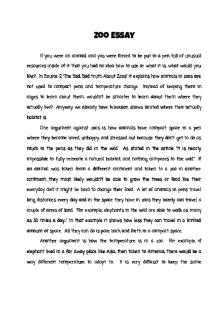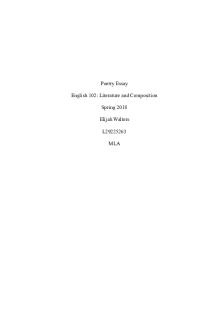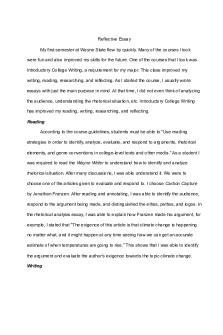Essay \"Ecological vs. constructivist approach\" - grade B PDF

| Title | Essay \"Ecological vs. constructivist approach\" - grade B |
|---|---|
| Course | Cognitive Psychology |
| Institution | University of Westminster |
| Pages | 2 |
| File Size | 56.7 KB |
| File Type | |
| Total Downloads | 30 |
| Total Views | 148 |
Summary
Ecological vs. constructivist approach...
Description
Ecological vs. constructivist approach Critically evaluate the ecological & constructivist approaches to visual perception The constructivist approach =Perception is indirect: Gregory (1980) argued that perception is a constructive process which relies on top-down processing. Our perceptions of the world are hypotheses that stem from sources such as knowledge and experience. Perception is based on three stages: 1) external stimuli are sensed, 2) and then 3) former knowledge that is stored in the long term memory is activated, until the activation of high level cognitive for inferring ( Shiffman, 2001). This is known as Helmholtz’s ‘unconscious inference’. Therefore, perception can also be understood as a rational cognitive process (Gordon, 2004). Successful perception requires cognitive processes combining thoughts, intelligence and information from visual senses together with the knowledge gained from prior experience (Gordon, 2004). Evidence: Gordon (2004) asked children to write down what they had seen after a series of ambiguous pictures were shown. He found that children were more likely to respond with food-related answers when they were hungry than when they were not. This study illustrates that hunger can be a contributing factor or higher order process that could influence perception. Participants were asked to loot at an image using a tachistoscope (displays a picture at millisecond speed) and to report what they had seen. The picture was of a man wearing a naval cap and many participants had reported that the man had a beard (which was the current stereotype of a naval officer). This supports that higher cognitive processes were involved in the perception process (Taylor and Maslin, 1970). The optic illusion of Charlie Chaplin would act as support for constructivism because although it is merely a hollow mask, we reconstruct the face due to our prior experiences of what a face should look like. This is similar to the Necker Cube illusion because when participants stare at the crosses on the cube the orientation can suddenly change. This is because the brain develops two equally plausible hypotheses and is unable to decide them (McLeod, 2007).
Ecological approach = perception is direct Gibson (1966) argued that perception is direct and based on bottom-up processing, which means that signal travels in one-direction, from the retina to the visual cortex in the brain. Our environment can sufficiently supply details related to the stimulus (e.g. size, shape and distance etc). Gibson based his theory on 3 components: 1) optic flow patterns, 2) invariant features and 3) affordances. Changes in the flow of the optic array contain important information about what type of movement is taking place. Any flow in the optic array means that the perceiver is moving, if there is no flow the perceiver is static. Invariant features such as texture gradient and linear perspective are important for depth perception. Affordances are cues in the environment that aid perception (reference). Evidence + Invariant motion of human body allows interpretation of form/ Point light displays (Johansson, 1975). -Although Gibson’s ecological theory is able to account for fast perception of the environment, it fails to explain why perceptions are sometimes inaccurate such as illusions (reference). Conclusion Combines both top down and bottom up process: Neisser (1976) known as the ‘Perceptual Cycle’ Bibliography http://www.simplypsychology.org/perception-theories.html http://www.ukessays.com/essays/psychology/evidence-for-the-constructivist-theory-ofvisual-perception-psychology-essay.php Gregory https://explorable.com/top-down-vs-bottom-up-processing https://books.google.co.uk/books? id=CC3OBQAAQBAJ&pg=PA289&lpg=PA289&dq=Swinging+room++%28e.g.,+Lee+ %26+Lishman, +1975%29&source=bl&ots=BRRgs35hZE&sig=h451h9EAaxYouJm4WStc5XhI0X4&hl=en&sa=X& ei=RuUvVfuGE8GMaNy4gbgI&ved=0CC0Q6AEwBA#v=onepage&q=Swinging%20room %20%20(e.g.%2C%20Lee%20%26%20Lishman%2C%201975)&f=false AO2 for Gibson!...
Similar Free PDFs

Rogerian Essay - Grade: B
- 2 Pages

Zoo Essay - Grade: B+
- 2 Pages

Causation Essay - Grade: B
- 4 Pages

Final Essay - Grade: B+
- 12 Pages

Propaganda Essay - Grade: b
- 4 Pages

Poetry Essay - Grade: B
- 5 Pages

Galileo Essay - Grade: B+
- 6 Pages

Fiction Essay - Grade: B
- 7 Pages

EPQ Essay - Grade: B+
- 10 Pages

Law essay - Grade: B
- 9 Pages

Persuasive Essay - Grade: B
- 3 Pages

Evicted Essay - Grade: B+
- 3 Pages

Charities essay - Grade: B+
- 13 Pages

Reflective Essay - Grade: B
- 4 Pages

Analysis essay - Grade: B+
- 3 Pages
Popular Institutions
- Tinajero National High School - Annex
- Politeknik Caltex Riau
- Yokohama City University
- SGT University
- University of Al-Qadisiyah
- Divine Word College of Vigan
- Techniek College Rotterdam
- Universidade de Santiago
- Universiti Teknologi MARA Cawangan Johor Kampus Pasir Gudang
- Poltekkes Kemenkes Yogyakarta
- Baguio City National High School
- Colegio san marcos
- preparatoria uno
- Centro de Bachillerato Tecnológico Industrial y de Servicios No. 107
- Dalian Maritime University
- Quang Trung Secondary School
- Colegio Tecnológico en Informática
- Corporación Regional de Educación Superior
- Grupo CEDVA
- Dar Al Uloom University
- Centro de Estudios Preuniversitarios de la Universidad Nacional de Ingeniería
- 上智大学
- Aakash International School, Nuna Majara
- San Felipe Neri Catholic School
- Kang Chiao International School - New Taipei City
- Misamis Occidental National High School
- Institución Educativa Escuela Normal Juan Ladrilleros
- Kolehiyo ng Pantukan
- Batanes State College
- Instituto Continental
- Sekolah Menengah Kejuruan Kesehatan Kaltara (Tarakan)
- Colegio de La Inmaculada Concepcion - Cebu
